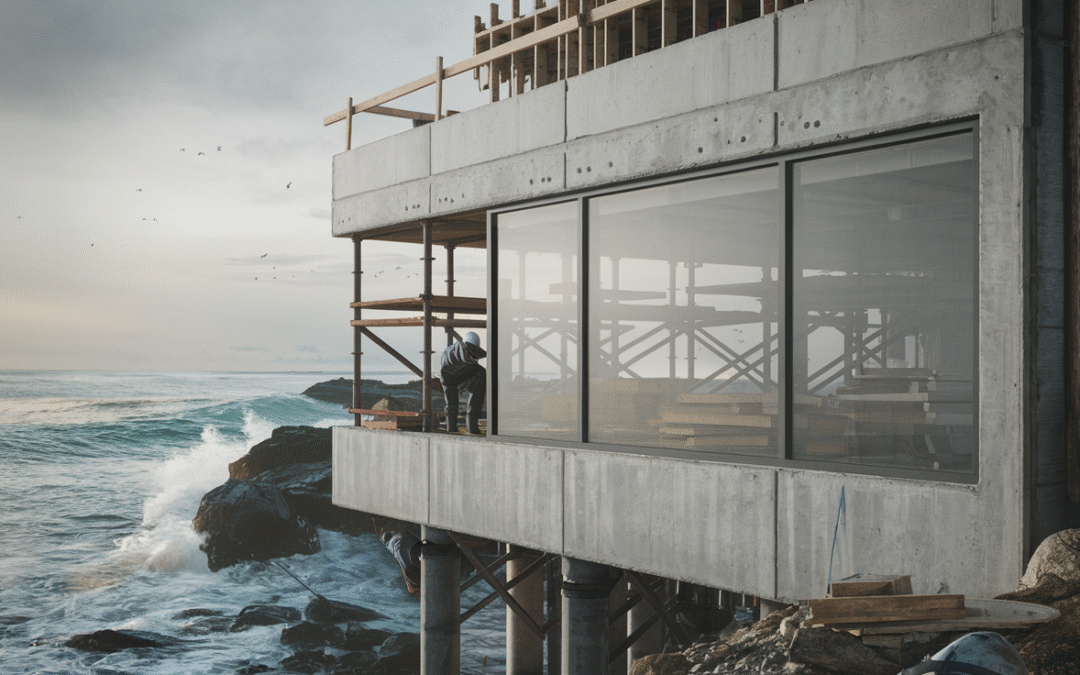Table of Contents
- Introduction
- Importance of Façade Materials in Coastal Areas
- Choosing the Right Materials
- Examples of Durable Materials
- Considering Environmental Impact
- Case Study: Grocery Store on the Coast
- Challenges in Coastal Construction
- Embracing Innovative Techniques
- Conclusion
- Get Started with iBuild
Introduction
Building in coastal environments, such as those found across the San Francisco Bay Area, presents unique challenges due to the corrosive elements like saltwater and wind. Selecting the right coastal commercial façade materials is integral to the longevity and integrity of commercial properties. This article explores how to make well-informed choices to ensure both aesthetic appeal and functional resilience, solving real-world issues faced by property developers and investors.
Importance of Façade Materials in Coastal Areas
Façade materials form the first line of defense against harsh coastal conditions, directly impacting a building’s durability and maintenance needs. In regions like Burlingame and San Rafael, where the salt air is prevalent, choosing the correct materials ensures that structures require less frequent repairs, thus saving on long-term operational costs. Opting for durable façade solutions helps maintain a building’s integrity and curb appeal.
Choosing the Right Materials
Selecting materials for coastal commercial façades requires a balance between aesthetics, cost, and durability. It’s important to consider material properties that resist corrosion, reduce thermal stress, and withstand high humidity levels typical of coastal environments.
Corrosion Resistance
Materials like aluminum or stainless steel are highly resistant to rust and corrosion, making them excellent choices for exterior façades. These metals withstand the saline environment that characterizes coastal areas.
Thermal Performance
Choosing materials with superior thermal performance is crucial. Materials such as concrete and high-performance glass help to minimize energy costs by enhancing insulation and keeping interior temperatures stable.
Examples of Durable Materials
The selection of sturdy and enduring materials is essential for coastal environments. Here are some of the top choices:
Fiber Cement
Fiber cement provides excellent durability and is available in a range of textures and finishes. Its ability to withstand harsh weather conditions makes it a favorite for coastal properties.
Weatherproof Wood
Using treated wood varieties can offer aesthetic appeal and durability, allowing buildings to blend with natural environments while resisting decay and insects.
Considering Environmental Impact
Builders and developers must consider the environmental impacts of their material choices. Sustainable materials reduce the carbon footprint and are often economically viable in the long run. iBuild Design and Construction emphasizes eco-friendly practices to meet LEED criteria and other sustainability standards (https://ibuild-design.com/services/).
Case Study: Grocery Store on the Coast
Imagine constructing a grocery store in coastal Burlingame, where iBuild’s team was tasked with developing a durable but inviting façade. By using composite panels and innovative weatherproofing techniques, they achieved a visually appealing design that stood the test of time and minimized maintenance costs, ultimately enhancing customer experience and boosting store profitability.
Challenges in Coastal Construction
Construction in coastal areas is fraught with challenges like material degradation and moisture control. These issues require advanced planning and careful choice of materials to prevent structural issues like rust and mold growth, which could compromise the building’s structural integrity.
Managing Moisture and Mold Risks
Proper sealing and insulation are critical in preventing moisture infiltration. Using vapor barriers and ensuring proper ventilation in the design phase are critical steps to mitigate mold risks in humid environments.
Embracing Innovative Techniques
Innovation drives sustainable and efficient construction practices. Techniques like prefabrication and 3D modeling enable developers to visualize and test design concepts before execution, ensuring optimal material selection for coastal facades.
Smart Materials
Advanced smart materials that change properties based on environmental stimuli offer innovative solutions. For instance, self-healing concrete can address cracks that naturally happen due to stress and environmental conditions.
Conclusion
When constructing commercial properties in coastal areas, the choice of façade materials is critical to the success and longevity of the building. iBuild Design and Construction offers expert guidance on selecting materials that balance durability and aesthetics while considering environmental impacts. By implementing smart design solutions, you can ensure that your coastal property remains an asset and a beacon of innovation.
Get Started with iBuild
As you embark on your next construction project, partner with a trusted design-build firm that understands the unique challenges of coastal environments. Contact iBuild Design and Construction to learn more about our architect-led approach and how we can help turn your vision into reality. Get in touch today to discuss your project needs and receive a tailored assessment.

